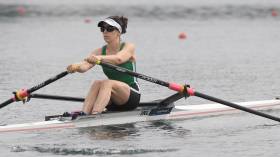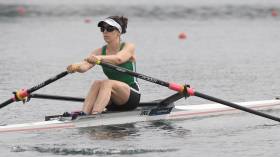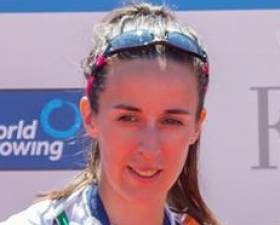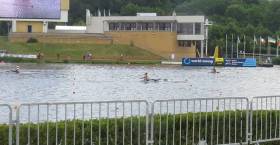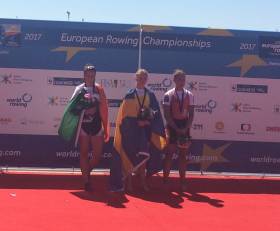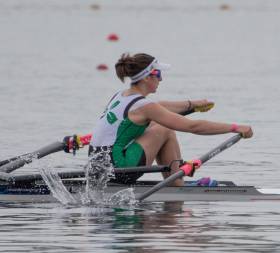Displaying items by tag: Denise Walsh
O'Donovan Adds Second Gold Medal for Ireland at World Rowing Championships
Walsh Continues Winning Run for Ireland at World Championships
#Rowing: Denise Walsh took an excellent first place in her semi-final at the World Rowing Championships in Sarasota Bradenton in Florida today, making it two wins out of two races for Ireland on the day.
The Skibbereen lightweight sculler took a slight lead over Mary Jones at half way, with Emma Fredh of Sweden in third. These three then moved away from the rest. Walsh would not let either challenger head her – at the finish the trio finished in the same order, with less than a second covering them.
Kirsten McCann of South Africa won the first semi-final from Patricia Merz of Switzerland.
Earlier, Paul O’Donovan had won his semi-final of the lightweight men’s single sculls.
World Rowing Championships, Sarasota-Bradenton, Day Five – Irish interest:
Men
Lightweight Single Sculls – A/B Semi-Final One (First Three to A Final; rest to B Final): 1 Ireland (P O’Donovan) 6:55.30, Switzerland (E Schmid) 6:59.04, 3 Brazil (U Batista) 7:00.47.
Semi-Final Two: 1 Norway (K Brun) 6:54.02, 2 New Zealand (M Dunham) 6:55.68, 3 Germany (L Wichert) 6:57.11.
Women
Lightweight Single Sculls – A/B Semi-Final Two (First Three to A Final; rest to B Final): 1 Ireland (D Walsh) 7:45.89, United States (M Jones) 7:46.54, Sweden (E Fredh) 7:46.78.
Semi-Final One: 1 South Africa (K McCann) 7:39.55, 2 Switzerland (P Merz) 7:39.63, 3 The Netherlands (M Keijser) 7:49.17.
Walsh Continues Ireland's Winning Run in World Rowing Heats
#Rowing: Denise Walsh made it three wins out of three starts for Ireland at the World Rowing Championships in Florida today. The Ireland lightweight single sculler charged to the line to beat Kirsten McCann of South Africa in an exciting finish to their heat.
Earlier Paul O’Donovan, in the lightweight single and the lightweight pair of Shane O’Driscoll and Mark O’Donovan had also won.
World Rowing Championships, Sarasota-Bradenton, Florida – Day One – Irish Interest:
Men
Lightweight Pair – Heat One (First to A Final; rest to Repechage): 1 Ireland (M O’Donovan, S O’Driscoll) 6:33.20, 2 Britain (J Cassells, S Scrimgeour) 6:38.57, 3 Italy 6:40.39.
Lightweight Single Sculls – Heat Three (First Four to Quarter-Finals; rest to Repechages): 1 Ireland (P O’Donovan) 6:54.68, 2 Brazil 7:05.75, 3 Italy 7:09.88, 4 Thailand 7:17.50.
Women
Lightweight Single Sculls – Heat Three (First Three to A/B Semi-Finals; rest to Repechages): 1 Ireland (D Walsh) 7:43.87, 2 South Africa 7:44.38, 3 Italy 8:03.34.
Sixth For Walsh in Remarkable Rowing Final
#Rowing: Denise Walsh finished sixth in the A Final of the lightweight single sculls here at Poznan, Poland. Joanna Dorociak of Poland, surprisingly, led for most of the race, but it was Jackie Kiddle of New Zealand who came through and won in an exciting finish. Patricia Merz of Switzerland was third, just over half a second ahead of European champion Emma Fredh of Sweden.
Walsh was fell off the pace by halfway and could not make it up in a fast World Cup final.
World Cup Regatta, Poznan, Day Two (Irish interest; selected results)
Women
Pair – Repechage (First Four to A Final; rest to B Final): Australia 7:15.41, 2 New Zealand 7:16.26, 3 Chile 7:17.86, 4 Britain 7:22.94; 5 United States Two 7:28.76, 6 Ireland (A Keogh, A Crowley) 7:35.93.
Single Sculls – Semi-Finals (First Three to A Final; rest to B Final)
Semi-Final One: 1 Austria (M Lobnig) 7:29.08, 2 China (J Duan) 7:31.25, 3 New Zealand (H Osborne) 7:32.80; 4 Ireland One (S Puspure) 7:35.99, 5 Austria Two 7:42.16, 6 Germany Two 7:49.93.
Semi-Final Two: 1 Britain (V Thornley) 7:29.58, 2 Germany (A Thiele) 7:33.43, 3 Ukraine (D Dymchenko) 7:35.50; 4 Ireland Two (M Dukarska) 7:37.19, 5 United States One 7:38.05, 6 United States Two 7:42.84.
Lightweight Single Sculls – Semi-Finals (Three to A Final; rest to B Final) – Semi-Final One: 1 New Zealand 7:44.06, 2 Poland 7:45.45, 3 Switzerland 7:48.27.
Semi-Final Two: 1 Sweden (E Fredh) 7:40.68, 2 United States (M Jones) 7:41.38, 3 Ireland (D Walsh) 7:42.79; 4 Russia 7:44.47, 5 Netherlands 7:51.60, 6 Austria 7:58.54.
A Final: 1 New Zealand 7:36.89, 2 Poland 7:37.19, 3 Switzerland 7:37.20; 4 Sweden 7:37.75, 5 United States 7:43.07, 6 Ireland (Walsh) 7:48.91.
Walsh Qualifies for A Final in Tight Race
#Rowing: Denise Walsh qualifed for the A Final of the lightweight single sculls by finishing third in her semi-final at the World Cup Regatta in Poznan, Poland, today. Emma Fredh and Walsh battled with Mary Jones of the United States for the crucial top-three spots. Jones took over in second to Fredh at 1500 metres, with Walsh holding off Russia’s Anastasia Lebedeva for third. Walsh sprinted from there, but so did Jones, who took second.
Aifric Keogh and Aileen Crowley finished sixth in the pairs repechage, off the pace in a fast race. They will go to the B Final.
World Cup Regatta, Poznan, Day Two (Irish interest; selected results)
Women
Pair – Repechage (First Four to A Final; rest to B Final): Australia 7:15.41, 2 New Zealand 7:16.26, 3 Chile 7:17.86, 4 Britain 7:22.94; 5 United States Two 7:28.76, 6 Ireland (A Keogh, A Crowley) 7:35.93.
Lightweight Single Sculls – Semi-Finals (Three to A Final; rest to B Final) – Semi-Final One: 1 New Zealand 7:44.06, 2 Poland 7:45.45, 3 Switzerland 7:48.27.
Semi-Final Two: 1 Sweden (E Fredh) 7:40.68, 2 United States (M Jones) 7:41.38, 3 Ireland (D Walsh) 7:42.79; 4 Russia 7:44.47, 5 Netherlands 7:51.60, 6 Austria 7:58.54.
Walsh Holds of Pole To Take Place in World Cup Semi-Finals
#Rowing: Denise Walsh took a fine second place in her heat of the lightweight single sculls to qualify directly for the semi-finals of the World Cup Regatta in Poznan, Poland, today. Patricia Merz of Switzerland won, while the Skibbereen woman held off a challenge by Joanna Dorociak of Poland, who will compete in a repechage.
The heat was the fastest of three in tailwind conditions. Emma Fredh of Sweden and newcomer Jackie Kiddle of New Zealand won the other heats.
World Cup Regatta, Poznan, Poland, Day One (Selected Results; Irish interest)
Women
Lightweight Single Sculls Heats (First Two to A/B Semi-Finals; rest to Repechages – Heat One: 1 New Zealand (J Kiddle) 7:30.91, 2 Russia (A Lebedeva) 7:31.79. Heat Two: 1 Sweden One (E Fredh) 7:33.26, 2 Germany (L Pieper) 7:41.81. Heat Three: 1 Switzerland (P Merz) 7:29.28, 2 Ireland (D Walsh) 7:32.72; 3 Poland One 7:36.38.
#Rowing: Ireland made a brilliant start to the final day of the European Rowing Championships.
Mark O’Donovan and Shane O’Driscoll dominated the men’s lightweight pair to take gold and, immediately afterwards, Denise Walsh took a gutsy silver medal in the lightweight single sculls.
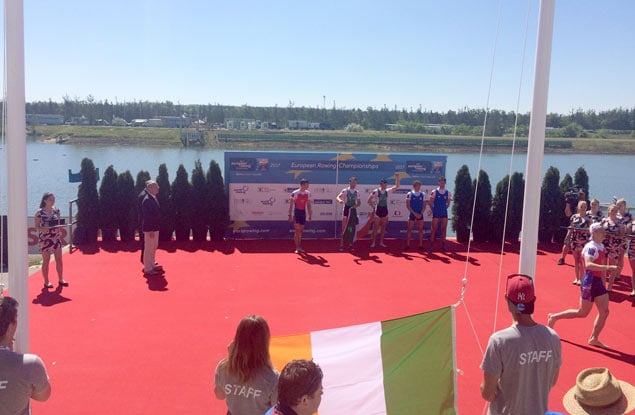 Mark O'Donovan and Shane O'Driscoll medal ceremony
Mark O'Donovan and Shane O'Driscoll medal ceremony
European Rowing Championships, Day Three (Selected Results; Irish interest)
Men
Lightweight Pair – A Final:
1 Ireland (M O’Donovan, S O’Driscoll) 6:32.34, 2 Russia 6:34.74, 3 Italy 6:34.89; 4 Britain (J Cassells, S Scrimgeour) 6:39.75.
Women
Lightweight Single Sculls – A Final: 1 Sweden (E Fred) 7:36.24, 2 Ireland (D Walsh) 7:38.00, 3 Switzerland (P Merz) 7:39.94.
Denise Walsh Secures A Final Spot at European Rowing
#Rowing: Denise Walsh qualified for the A Final of the lightweight single sculls by finishing second in her semi-final at the European Rowing Championships in Racice today. The race was won, with a dominant peformance, by Patricia Merz of Switzerland. She started well, built a clearwater lead by halfway and showed no weakness as Walsh tried to reel her in in. Italy’s Clara Guerra took third place and the other A Final spot.
In the second semi-final, Sweden’s Emma Fred won in a slightly better time than Merz’s, but she was pushed by Anastasia Lebedeva of Russia and Germany’s Leonie Pieper, who took the remaining A Final slots.
European Rowing Championships, Day Two (Selected Results; Irish interest)
Women
Lightweight Single Sculls – Semi-Final One: Switzerland (P Merz) 7:39.48, 2 Ireland (D Walsh) 7:42.53, 3 Italy (C Guerra) 7:43.99.
Semi-Final Two:
1 Sweden (E Fred) 7:36.74, 2 Russia (A Lebedeva) 7:37.90, 3 Germany (L Pieper) 7:42.46.
Walsh Wins European Heat in Impressive Fashion
#Rowing: Denise Walsh put in an impressive performance to win her heat of the lightweight single sculls at the European Rowing Championships in Racice in the Czech Republic. The bright sunshine had abated, but the Skibbereen woman took full advantage of the duller, tailwind conditions. She took a strong lead in the second half and was never truly tested from there. The small Ireland crowd cheered her over the line.
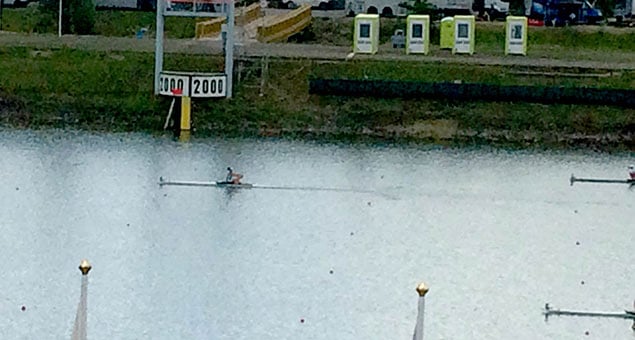 Denise Walsh crosses the line first in Racice this morning
Denise Walsh crosses the line first in Racice this morning
European Championships, Racice, Czech Republic, Day One (Selected Results; Irish interest)
Women
Lightweight Single Sculls – Heat One (First Three to Semi-Finals; rest to Repechage): 1 Ireland (D Walsh) 7:44.85, 2 Denmark 7:49.49, 3 Poland 7:49.90; 4 Czech Republic 8:05.07, 5 Portugal 8:08.19.
Denise Walsh Takes World Cup Silver For Ireland
#Rowing: Denise Walsh took silver for Ireland at the World Cup Regatta in Belgrade this morning. The Skibbereen woman, who had won her heat with a wonderful finish, came through the field to take second behind Patricia Merz of Switzerland. Merz had established a clear lead with a quarter of the race to go, and Walsh lay in fourth at this stage. But she upped her rate, moved into medal position and then passed Poland’s Joanna Dorociak to take a second medal for Ireland. The men’s lightweight pair had earlier taken gold.
“In the race, I focused on giving a bit of reserve toward the end and focusing on the sprint. I didn’t realize how close everyone was to me, especially Patricia. Now focusing on the European Champs in the single,” Walsh told worldrowing.com.
World Cup Regatta, Belgrade (Selected results; Irish interest)
Men
Lightweight Pair – Final: 1 Ireland (M O’Donovan, S O’Driscoll) 6:46.65, 2 Russia 6:47.67, 3 Britain (J Cassells, S Scrimgeour) 6:48.40.
Women
Lightweight Single Sculls – A Final: 1 Switzerland (P Merz) 7:52.30, 2 Ireland (D Walsh) 7:56.24, 3 Poland (J Dorociak) 7:59.22.



























